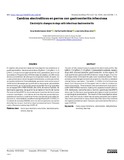Mostrar el registro sencillo del ítem
Cambios electrolíticos en perros con gastroenteritis infecciosa
| dc.rights.license | http://creativecommons.org/licenses/by-nc-sa/3.0/ve/ | es_VE |
| dc.contributor.author | Guaman-Simba, Dorys Daniela | |
| dc.contributor.author | Castillo-Hidalgo, Edy | |
| dc.contributor.author | Armas-Ariza, Juan Carlos | |
| dc.date.accessioned | 2022-08-01T02:26:50Z | |
| dc.date.available | 2022-08-01T02:26:50Z | |
| dc.date.issued | 2022 | |
| dc.identifier.issn | 0798-2259 | |
| dc.identifier.uri | http://www.saber.ula.ve/handle/123456789/48353 | |
| dc.description.abstract | El objetivo del presente trabajo de investigación fue establecer el perfil electrolítico: Na (micromol·litros-1) [μMol·L-1], K (μMol·L-1), Cl (μMol·L-1), en perros con gastroenteritis viral y parasitaria, para lo cual se analizaron 30 pacientes (n=30) de todas las edades y sin diferencia de sexo, procedentes del albergue municipal de Ambato, Ecuador, los cuales presentaron síntomas gastrointestinales, a estos pacientes se levantó la Historia Clínica detallada, posterior a ello se tomaron 2 mililitros (mL) de sangre por punción de la vena yugular, para análisis de electrolitos, las muestras de sangre obtenidas fueron procesadas en un equipo DRI-CHEM NX500i, año 2016, de marca Fujifilm; de fabricación japonesa; de igual forma se realizó el Test Kit de Canine Parvovirus (SensPERT) y se recolectaron muestras de heces para examen coprológico. Los valores de K en diarreas producidas por parásitos se mostraron superiores frente a las diarreas producidas por parvovirus, mostrándose una diferencia significativa (P<0,0002), en el análisis de varianza (ANAVA); entre los microorganismos causantes de la diarrea, los que mostraron mayor prevalencia fueron Toxocara canis y Parvovirus canino tipo 2 (CPV-2). | es_VE |
| dc.language.iso | es | es_VE |
| dc.publisher | SaberULA | es_VE |
| dc.rights | info:eu-repo/semantics/openAccess | es_VE |
| dc.subject | Canis lupus familiaris | es_VE |
| dc.subject | Electrólito | es_VE |
| dc.subject | Deshidratación | es_VE |
| dc.subject | Vómito | es_VE |
| dc.subject | Diarrea | es_VE |
| dc.title | Cambios electrolíticos en perros con gastroenteritis infecciosa | es_VE |
| dc.title.alternative | Electrolytic changes in dogs with infectious Gastroenteritis | es_VE |
| dc.type | info:eu-repo/semantics/article | es_VE |
| dc.description.abstract1 | The aim of this research was to analyze the electrolyte profile: Na (μMol·L-1), K (μMol·L-1), Cl (μMol·L-1), presented in animals, namely dogs with viral and parasitic gastroenteritis. In this regard, 30 male and female patients (n=30) of distinct range of ages, from the Municipal shelter of Ambato-Ecuador were treated and tested. These animals presented gastrointestinal symptoms; therefore, a detailed clinical history was taken. Thereafter, 2 mililiter (mL) of blood was taken from the puncture of the jugular vein in order to conduct an electrolyte analysis. These analyses were processed and conducted in a DRI-CHEM NX500i machine, made by the Japanese brand Fujifilm in 2016. Additionally, Canine Parvovirus Test kits, specifically (SensPERT) were used. Furthermore, stool samples were taken in order to conduct a coprological examination. The result of this investigation show cases that the K values in diarrhea caused by parasites were higher than those presented in cases where diarrhea those that showed the highest prevalence were Toxocara canis and Canine Parvovirus type 2 (CPV-2). | es_VE |
| dc.description.email | dorys.guaman.62@est.ucacue.edu.ec | es_VE |
| dc.identifier.depositolegal | pp199102ZU46 | |
| dc.identifier.edepositolegal | ppi201502ZU4665 | |
| dc.identifier.eissn | 2477-944X | |
| dc.publisher.pais | Venezuela | es_VE |
| dc.subject.institucion | Universidad del Zulia (LUZ) | es_VE |
| dc.subject.institucion | Universidad de Los Andes (ULA) | es_VE |
| dc.subject.keywords | Canis lupus familiaris | es_VE |
| dc.subject.keywords | Electrolyte | es_VE |
| dc.subject.keywords | Dehydration | es_VE |
| dc.subject.keywords | Vomiting | es_VE |
| dc.subject.keywords | Diarrhea | es_VE |
| dc.subject.publicacionelectronica | Revista Científica | |
| dc.subject.seccion | Revista Científica: Artículos | es_VE |
| dc.subject.thematiccategory | Medio Ambiente | es_VE |
| dc.subject.tipo | Revistas | es_VE |
| dc.type.media | Texto | es_VE |


